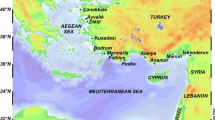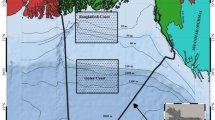Abstract
Sea surface temperature (SST) data obtained from coastal stations in Jiangsu, China during 2010–2014 are quality controlled before analysis of their characteristic semidiurnal and seasonal cycles, including the correlation with the variation of the tide. Quality control of data includes the validation of extreme values and checking of hourly values based on temporally adjacent data points, with 0.15°C/h considered a suitable threshold for detecting abnormal values. The diurnal variation amplitude of the SST data is greater in spring and summer than in autumn and winter. The diurnal variation of SST has bimodal structure on most days, i.e., SST has a significant semidiurnal cycle. Moreover, the semidiurnal cycle of SST is negatively correlated with the tidal data from March to August, but positively correlated with the tidal data from October to January. Little correlation is detected in the remaining months because of the weak coastal-offshore SST gradients. The quality control and understanding of coastal SST data are particularly relevant with regard to the validation of indirect measurements such as satellite-derived data.
Similar content being viewed by others
References
Cai W, Whetton P H. 2001. Modes of SST variability and the fluctuation of global mean temperature. Climate Dynamics, 17(11): 889–901, doi: https://doi.org/10.1007/s003820100152
Chen Shangji, He Weihuan, Yao Shiyu, et al. 1992. The hydro-climatic seasons division of Chinese offshore marine. Haiyang Xuebao (in Chinese), 14(6): 1–11
Dash P, Ignatov A, Kihai Y, et al. 2010. The SST quality monitor (SQUAM). Journal of Atmospheric and Oceanic Technology, 27(11): 1899–1917, doi: https://doi.org/10.1175/2010JTECHO756.1
Ding Yuguo, Li Jiayun, Jiang Zhihong, et al. 2011. Advances in extremes statistics and their application to climate change study. Advances in Climate Change Research (in Chinese), 7(4): 248–252
Donlon C J, Minnett P J, Gentemann C, et al. 2002. Toward improved validation of satellite sea surface skin temperature measurements for climate research. Journal of Climate, 15(4): 353–369, doi: 10.1175/1520-0442(2002)015<0353:TIVOSS>2.0.CO;2
Emery W J, Baldwin D J, Schlüssel P, et al. 2001. Accuracy of in situ sea surface temperatures used to calibrate infrared satellite measurements. Journal of Geophysical Research, 106(C2): 2387–2405, doi: https://doi.org/10.1029/2000JC000246
Feng Song, Hu Qi, Qian Weihong. 2004. Quality control of daily meteorological data in China, 1951–2000: a new dataset. International Journal of Climatology, 24(7): 853–870, doi: https://doi.org/10.1002/joc.1047
Filipiak M J, Merchant C J, Kettle H, et al. 2012. An empirical model for the statistics of sea surface diurnal warming. Ocean Science, 8(2): 197–209, doi: https://doi.org/10.5194/os-8-197-2012
Guo Weiqi, Sha Wei, Shen Hongmei, et al. 2005. Characteristics and trend of SST variation in the coastal region of the East China Sea. Haiyang Xuebao (in Chinese), 27(5): 1–8
He Jinhai, Yu Jingjing, Shen Xinyong. 2007. Impacts of SST and SST anomalies on low-frequency oscillation in the tropical atmosphere. Advances in Atmospheric Sciences, 24(3): 377–382, doi: https://doi.org/10.1007/s00376-007-0377-2
Huang N E, Shen Zheng, Long S R, et al. 1998. The empirical mode decomposition and the Hilbert spectrum for non-linear and non-stationary time series analysis. Proceedings of the Royal Society of London. Series A: Mathematical, Physical and Engineering Sciences, 454(1971): 903–995, doi: https://doi.org/10.1098/rspa.1998.0193
Kako S, Nakagawa T, Takayama K, et al. 2016. Impact of Changjiang River discharge on sea surface temperature in the East China Sea. Journal of Physical Oceanography, 46(6): 1735–1750, doi: https://doi.org/10.1175/JPO-D-15-0167.1
Kawai Y, Kawamura H. 2002. Evaluation of the diurnal warming of sea surface temperature using satellite-derived marine meteorological data. Journal of Oceanography, 58(6): 805–814, doi: https://doi.org/10.1023/A:1022867028876
Kawai Y, Wada A. 2007. Diurnal sea surface temperature variation and its impact on the atmosphere and ocean: A review. Journal of Oceanography, 63(5): 721–744, doi: https://doi.org/10.1007/s10872-007-0063-0
Kent E C, Kaplan A. 2006. Toward estimating climatic trends in SST. Part III: Systematic biases. Journal of Atmospheric and Oceanic Technology, 23(3): 487–500, doi: https://doi.org/10.1175/JTECH1845.1
Koner P K, Harris A, Maturi E. 2016. Hybrid cloud and error masking to improve the quality of deterministic satellite sea surface temperature retrieval and data coverage. Remote Sensing of Environment, 174: 266–278, doi: https://doi.org/10.1016/j.rse.2015.12.015
Liao Zhihong, Dong Qing, Xue Cunjun, et al. 2017. Reconstruction of daily sea surface temperature based on radial basis function networks. Remote Sensing, 9(12): 1204
Lin Rui, Zhang Caiyun, Li Yan. 2014. Satellite observation of the temporal and spatial variation of sea surface diurnal warming in the South China Sea. Journal of Tropical Oceanography (in Chinese), 33(2): 17–27
Liu Lihong, Zheng Zuguang, Ju Jianhua. 2008. Vacillations of the time series of annual temperature and precipitation in China based on EMD method. Plateau Meteorology (in Chinese), 27(5): 1060–1065
Liu Shan, Wang Hua, Jiang Hua, et al. 2013. Variation of sea surface temperature and its influence factors in the North Pacific. Haiyang Xuebao (in Chinese), 35(1): 63–75
Mao Zhihua, Zhu Qiankun, Pan Delu. 2003. A temperature error control technology for an operational satellite application system. Haiyang Xuebao (in Chinese), 25(5): 49–57
McClain E P, Pichel W G, Walton C C. 1985. Comparative performance of AVHRR-based multichannel sea surface temperatures. Journal of Geophysical Research, 90(C6): 11587–11601, doi: https://doi.org/10.1029/JC090iC06p11587
Meek D W, Hatfield J L. 1994. Data quality checking for single station meteorological databases. Agricultural and Forest Meteorology, 69(1–2): 85–109, doi: https://doi.org/10.1016/0168-1923(94)90083-3
Mochizuki T, Kida K. 2006. Seasonality of decadal sea surface temperature anomalies in the northwestern Pacific. Journal of Climate, 19(12): 2953–2968, doi: https://doi.org/10.1175/JCLI3807.1
O’Carroll A G, Eyre J R, Saunders R W. 2008. Three-way error analysis between AATSR, AMSR-E, and in situ sea surface temperature observations. Journal of Atmospheric and Oceanic Technology, 25(7): 1197–1207, doi: https://doi.org/10.1175/2007JTECHO542.1
Pan Haidong, Guo Zheng, Wang Yingying, et al. 2018. Application of the EMD method to river tides. Journal of Atmospheric & Oceanic Technology, 35(4): 809–819
Park T, Chan J J, Jungclaus J H, et al. 2011. Effects of the Changjiang river discharge on sea surface warming in the Yellow and East China Seas in summer. Continental Shelf Research, 31(1): 15–22, doi: https://doi.org/10.1016/j.csr.2010.10.012
Peng Jie, Ling Tiejun, Wang Bin. 2014. Simulation of diurnal variation of sea surface temperature in China offshore area using an ocean mixed layer turbulent energy forecast model. Marine Forecasts (in Chinese), 31(3): 1–9
Pimentel S, Haines K, Nichols N K. 2008. Modeling the diurnal variability of sea surface temperatures. Journal of Geophysical Research: Oceans, 113(C11): C11004, doi: https://doi.org/10.1029/2007JC004607
Qiu Fuwen, Pan Aijun, Zhang Shanwu, et al. 2016. Sea surface temperature anomalies in the South China Sea during mature phase of ENSO. Chinese Journal of Oceanology and Limnology, 34(3): 577–584, doi: https://doi.org/10.1007/s00343-016-4290-3
Schluessel P, Emery W J, Grassl H, et al. 1990. On the bulk-skin temperature difference and its impact on satellite remote sensing of sea surface temperature. Journal of Geophysical Research: Oceans, 95(C8): 13341–13356, doi: https://doi.org/10.1029/JC095iC08p13341
Stuart-Menteth A C, Robinson I S, Challenor P G. 2003. A global study of diurnal warming using satellite-derived sea surface temperature. Journal of Geophysical Research: Oceans, 108(C5): 3155, doi: https://doi.org/10.1029/2002JC001534
Tanahashi S, Kawamura H, Takahashi T, et al. 2003. Diurnal variations of sea surface temperature over the wide-ranging ocean using VISSR on board GMS. Journal of Geophysical Research: Oceans, 108(C7): 3216, doi: https://doi.org/10.1029/2002JC001313
Tu Qianguang, Pan Delu, Hao Zengzhou, et al. 2013. Quality control of satellite-retrieved sea surface temperature. In: Proceedings of the SPIE 8871, Satellite Data Compression, Communications, and Processing IX, 88710Q. San Diego, California, United States: SPIE
Wan Shiquan, Feng Guolin, Zhou Guohua, et al. 2005. Extracting useful information from the observations for the prediction based on EMD method. Acta Meteorologica Sinica (in Chinese), 63(4): 516–525
Wang Tao, Liu Tiegen, Liu Kun, et al. 2016. An EMD-based filtering algorithm for the fiber-optic SPR sensor. IEEE Photonics Journal, 8(3): 1–8
Wu Disheng, Zhang Juan, Liu Zenghong, et al. 2010. Subsurface ocean temperature of the western equatorial Pacific warm pool and the tropical cyclone. Journal of Tropical Meteorology (in Chinese), 26(2): 242–249
Xu Feng, Ignatov A. 2014. In situ SST quality monitor (iQuam). Journal of Atmospheric and Oceanic Technology, 31(1): 164–180, doi: https://doi.org/10.1175/JTECH-D-13-00121.1
Zhang Haifeng, Beggs H, Wang Xiaohua, et al. 2016. Seasonal patterns of SST diurnal variation over the Tropical Warm Pool region. Journal of Geophysical Research, 121(11): 8077–8094
Zhang Zhixin. 2014. Observation and analysis of coastal current and its adjacent current system in China offshore waters (in Chinese) [dissertation]. Qingdao: Ocean University of China
Author information
Authors and Affiliations
Corresponding author
Additional information
Foundation item: The Open Fund of State Key Laboratory of Satellite Ocean Environment Dynamics under contract No. SOED1402; the Youth Science and Technology Foundation of East China Sea Branch, SOA under contract No. 201624.
Rights and permissions
About this article
Cite this article
Yang, H., Gao, Q., Ji, H. et al. Sea surface temperature data from coastal observation stations: quality control and semidiurnal characteristics. Acta Oceanol. Sin. 38, 31–39 (2019). https://doi.org/10.1007/s13131-019-1496-1
Received:
Accepted:
Published:
Issue Date:
DOI: https://doi.org/10.1007/s13131-019-1496-1




